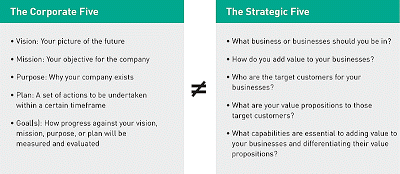
If you don’t yet subscribe to strategy+business by global management consulting firm Booz & Company, you are missing out on some impressive management and thought leadership pieces.
Two articles that recently caught my attention are:
- The Thought Leader Interview: Cynthia Montgomery by Ken Favaro and Art Kleiner
- How Leaders Mistake Execution for Strategy (and Why That Damages Both) by Ken Favaro
I am in complete agreement with Ken Favaro when he says that, “If the corporate five are the cart and strategy is the horse, leaders who put the cart first often end up with no horse at all.
Before they get to the corporate five, companies need to address five much more fundamental, and difficult, questions. Let’s call them the “the strategic five”:
1. What business or businesses should you be in?
2. How do you add value to your businesses? (in the comments section of the article, Ken elaborates stating “how a company contributes to the performance of its businesses relative to their respective markets“)
3. Who are the target customers for your businesses?
4. What are your value propositions to those target customers?
5. What capabilities are essential to adding value to your businesses and differentiating their value propositions?”
Source: http://www.strategy-business.com/article/cs00006?pg=all
I recall being involved in a big strategy presentation to around 100 execs of $Billion (revenue) sized company. The CEO was presenting and the slides appeared to have been put together by a major consulting firm. A number of slides talked about vision and provided data of where the company was versus where it needed to be. Unbelievably the majority of the examples used in the session were large retail company turnarounds. Why was this unbelievable? Because this company in question was a wholesaler. In a nutshell, they nailed The Corporate Five but ignored The Strategic Five. Many of the executives left the session utterly perplexed with a very senior exec commenting to me “Do they even know what business we are in?“. Long story short, what followed was years of loses including major market share erosion.
Cynthia Montgomery, the Timken Professor of Business Administration and former chair of the strategy unit at Harvard Business School has a resume many could only dream of, whether it be in the world of academia co-editoring with Michael Porter of the influential anthology Strategy: Seeking and Securing Competitive Advantage (Harvard Business School Press, 1991) or in the corporate world as Director at companies such as Newell Rubbermaid. Her insights into strategy are outstanding but it is how she defines the role of leadership in terms of the Chief Strategist that resonated so much with me when I thought of Ken Favaro’s “The Strategic Five”. Cynthia states, “When I think about a leader being the chief strategist what I mean is ultimately bearing responsibility for the choices that fundamentally determine what a business is and why it will matter…..Having a compelling answer to “Who are we and why do we matter?”, that’s where leadership starts. And for me that is what strategy is all about…”
As I have written before, building a solid fact base is critical in helping to devise a substantive strategy but as Cynthia points out “A leader builds a strategy through in-depth conversations with a group of his or her peers, testing the ideas against a variety of situations. Knowing how to do that well will serve the graduates better as leaders than any particular plan they develop at Harvard Business School.
When someone next starts talking to you about the strategic direction of the company you work for, at, in or own, ask yourself whether the conversation is centred on The Corporate Five or The Strategic Five. If the conversation is focused more on The Corporate Five then remember Cynthia’s words, “Having a compelling answer to “Who are we and why do we matter?”, that’s where leadership starts.”
If you are in a leadership role, or aspire to be in one, the last thing you want is executives leaving your meetings asking “Do they even know what business we are in?”
